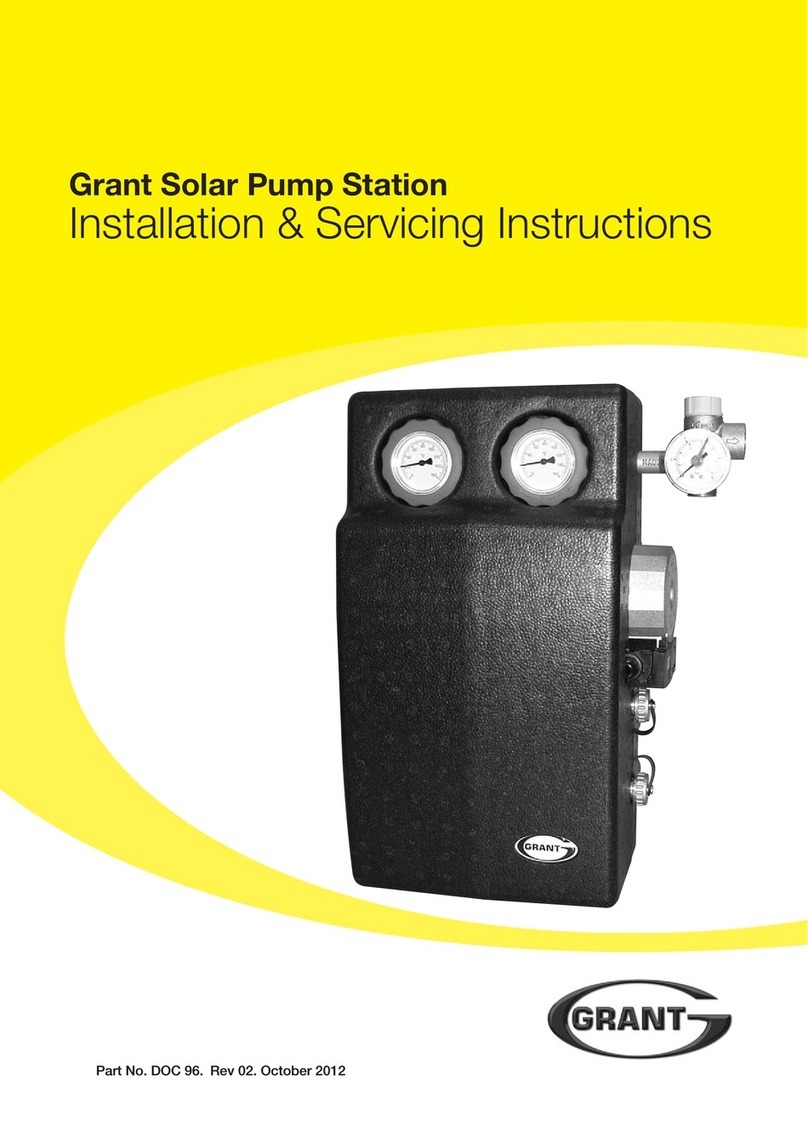
Section 3: Installation Page 9
3.1 GENERAL
Installation of this pump station must be carried out by a
competent installer in compliance with all current local Building
Regulations, codes of practice, Health & Safety legislation and
any relevant bylaws and regulations in force at the time.
electrician. The electrical installation must comply with the
requirements of the Electricity at Work Regulations 1989 and
BS7671:2008 - IET Wiring Regulations 17th Edition British
Standards Institutions (including all amendments).
3.2 REGULATIONS AND STANDARDS
The installation of the Grant Solar Pump Station must be in
accordance with the following recommendations, as applicable:
• Building Regulations for England and Wales, and Building
Standards for Scotland
• Local Bylaws (check with the Local Authority for the area)
• Water Supply (Water Fittings) Regulations 1999
The installation should also be in accordance with the latest
• BS7671 and amendments
• BS EN 12831
3.3 LOCATION
The Grant Solar Pump Station can be mounted on any suitable
wall surface capable of carrying the weight of the Grant Solar
Pump Station (refer to Table 2-1) where the required clearances
can be achieved. Leave at least 20 cm at each side of the Grant
Solar Pump Station.
Before mounting of the Grant Solar Pump Station an installation
damage to the elements of the Grant Solar Pump Station. The
pump group is designed for wall mounting in an upright position.
The Grant Solar Pump Station MUST only be installed inside
a property, and not located externally, as it not designed to be
weatherproof.
3.4 SAFETY
The Grant Solar Pump Station is intended only for closed solar
installation. The Grant Solar Pump Station complies with the
current technical standards and technical safety regulations.
Each device is checked for proper operation and safety prior to
shipping.
The Grant Solar Pump Station MUST only be installed and
operated by trained personnel. Untrained personnel can work only
under the supervision of an experienced person, who is familiar
with the way the unit works. Before installation, the installer must
carefully read and understand these instructions.
! WARNING !
The temperature inside the Grant Solar Pump Station can
reach dangerous temperatures that can cause serious
burns.
! WARNING !
Ensure that the electrical supply has been isolated before
making any wiring connections.
3 INSTALLATION
3.5 FITTING PROCEDURE
1. Refer to Figure 3-1. Take the two coach screws (3), the two
plugs (1) and the two metallic washers (2) from the wall
bracket kit
2. Remove the front section of the insulated pump station
housing
3.
4. Position the back section of the insulated housing in the
required location. If necessary check the cover is level using
a spirit level on the side and mark the top hole of the wall
bracket.
5.
set into the marked hole with a 10 mm drill bit.
6. Position the back section of the insulated housing in the
(3). Refer to Figure 3-2.
! CAUTION !
When xing the coach screw in step 6 proceed carefully.
The insulation is not rigid and overtightening the screw
could damage it.
7. Mark the position of the lower hole of the wall bracket on the
wall.
8. Remove the coach screw and carefully lift the back section of
the insulated housing
9.
pump set into the marked hole with a 10 mm drill bit
10. Fit
section of the insulated housing taking care to insert it
completely. Refer to Figure 3-3.
11. Lift the back section of the insulated housing and the wall
the two coach screws (3) and the two metallic washers (2).
Place the washers on the outside of the bracket mounting
holes, as shown in Figure 3-2.
! NOTE !
The Grant Solar Pump Station MUST only be installed
vertically, as shown in Figure 1-1.







































